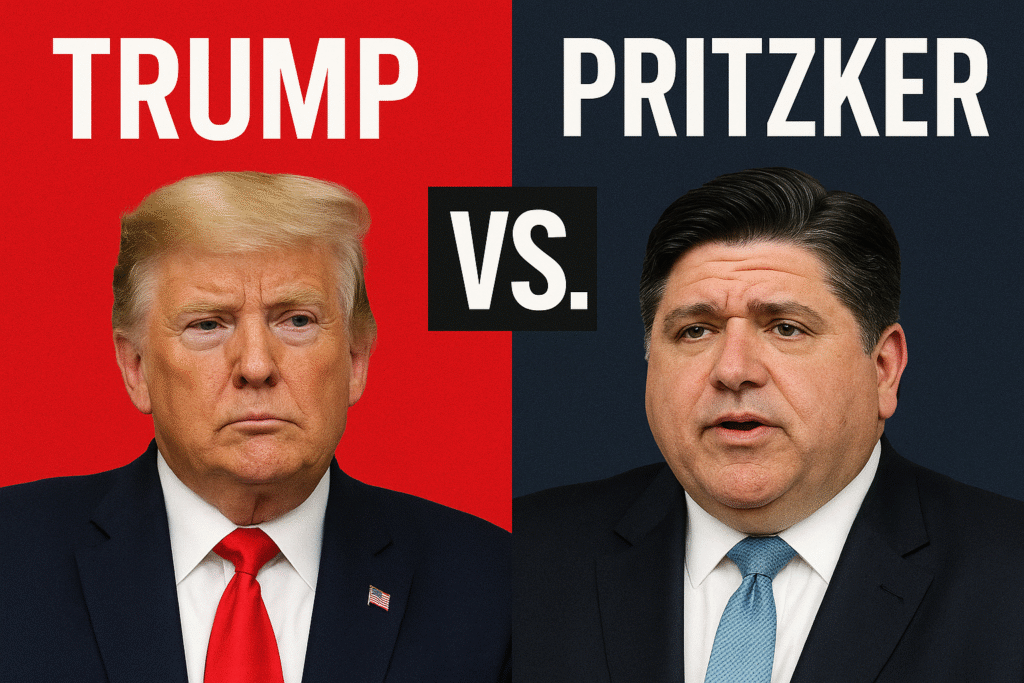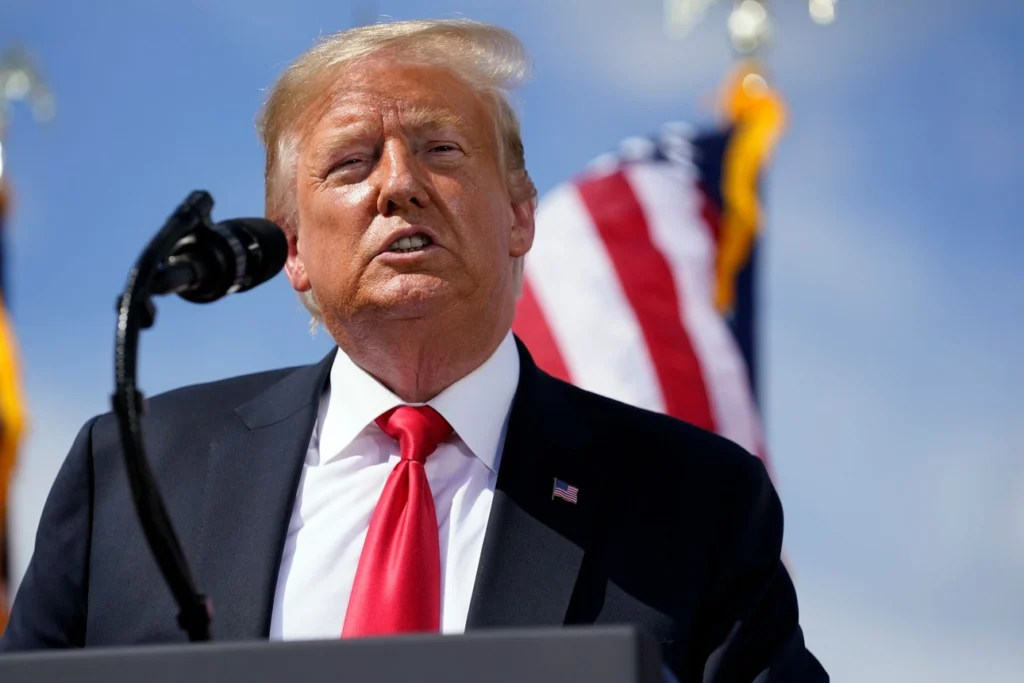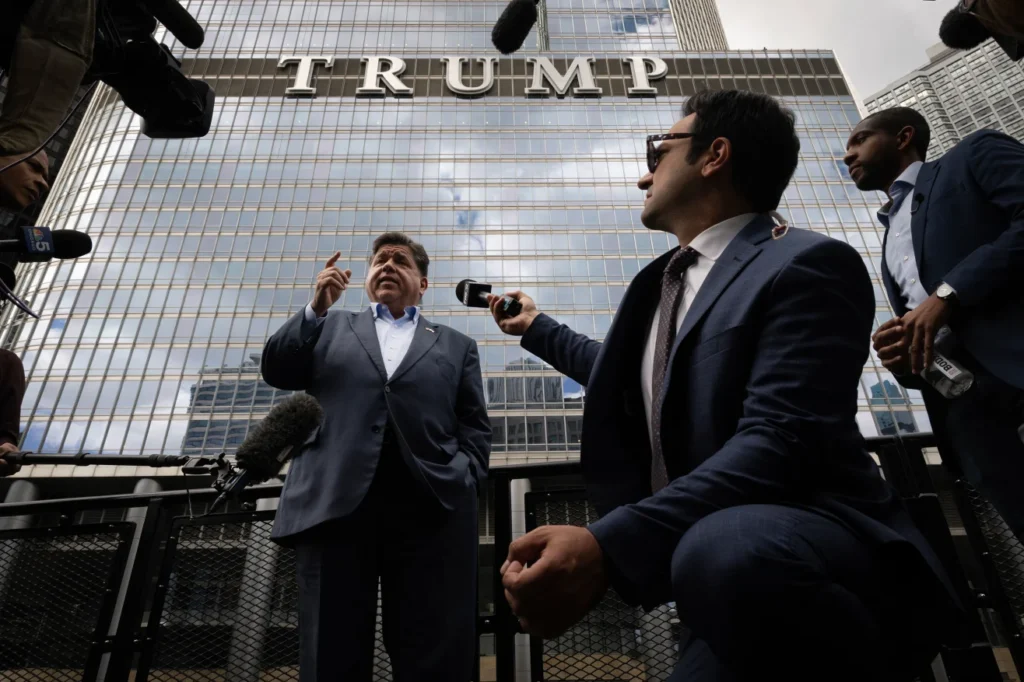“In a political landscape defined by bold personalities and clashing visions, few matchups spark as much curiosity as Donald Trump versus JB Pritzker—two powerful figures offering America two very different paths forward.”
As we explore the dynamics of this matchup, it’s crucial to analyze the implications of Trump vs. JB Pritzker for the future of American politics.

American politics has always been a story of big personalities and bigger ideas. Right now, two names that spark plenty of conversation are Donald Trump and JB Pritzker. Trump, the former president, is known for his blunt style, headline-grabbing statements, and a loyal base that sees him as a fighter against the establishment. On the other hand, Pritzker, the billionaire governor of Illinois, has carved out a different kind of political identity—one rooted in progressive policies, state leadership, and a quieter, but growing, national presence.
So, who really has the upper hand? Trump carries the weight of experience on the national stage, plus the ability to dominate news cycles like few others. Pritzker, meanwhile, brings resources, a strong record in Illinois, and a vision that appeals to those who want more government action on healthcare, education, and social equity.
This matchup isn’t just about two men. It’s about two competing visions of America’s future—one that looks back to a “make America great again” mindset, and another that leans into progressive reform and inclusion. And that makes the question of political edge less about popularity today and more about where the country wants to head tomorrow.
Background of Donald Trump
Political Journey & Achievements
Donald Trump’s political journey is unlike that of any other modern leader. Before entering politics, he was already a household name—known as a billionaire businessman, reality TV star, and real estate mogul. His leap into politics in 2015 shocked many, but it quickly became clear he had tapped into a deep sense of frustration among American voters.
In 2016, Trump won the presidency against Hillary Clinton, a result that stunned political analysts and redefined the Republican Party’s direction. During his time in office (2017–2021), he oversaw tax reforms, pushed for deregulation, renegotiated trade deals, and appointed three Supreme Court justices—shaping the judiciary for decades.

Even after leaving the White House, Trump has remained a central figure in American politics, with many seeing him as the most influential voice in the Republican Party.
Key Policies & Economic Vision
Trump’s policies often revolved around his “America First” philosophy. He prioritized reshaping trade deals to benefit U.S. workers, cutting corporate taxes, and reducing government regulations. His administration pushed for stronger border security and a tougher stance on immigration, while also promoting an energy strategy focused on oil, gas, and coal.
Economically, his presidency saw strong stock market growth and low unemployment rates before the COVID-19 pandemic struck. His supporters credit him with revitalizing U.S. manufacturing and standing up to China on trade, while critics argue that his policies favored the wealthy and worsened inequality.
Strengths and Criticisms
Trump’s greatest strength has always been his ability to connect with a large base of voters who feel ignored by traditional politicians. His direct, unpolished communication style—often through rallies and social media—made him stand out as a leader who wasn’t afraid to say what he thought. His willingness to challenge institutions and push back against critics also gave him a reputation as a fighter.
But Trump’s leadership came with heavy criticism. Many accused him of deepening political divisions, using inflammatory language, and undermining democratic norms. His handling of the COVID-19 pandemic drew sharp debate, as did his stance on climate change and international alliances. Perhaps most controversial was his refusal to fully accept the results of the 2020 election, which led to lasting debate over the state of U.S. democracy.
Background of JB Pritzker
Political Rise & Governorship in Illinois
JB Pritzker, a billionaire entrepreneur and philanthropist, comes from one of America’s wealthiest families. For years, he was more active behind the scenes in politics—funding Democratic causes and supporting candidates—before deciding to step into the spotlight himself. In 2018, he ran for governor of Illinois and won decisively, unseating Republican Bruce Rauner. His victory marked the beginning of a new era of Democratic leadership in the state.

As governor, Pritzker has leaned heavily into progressive politics. He was reelected in 2022, further cementing his influence, and has since been mentioned in national conversations as a potential Democratic presidential contender.
Strengths and Criticisms
Supporters often highlight Pritzker’s ability to turn his wealth into political independence—arguing he doesn’t need to bend to special interests in the same way career politicians do. His policy agenda appeals to progressives who want bold action on healthcare, education, and social equity. Many also credit him for stabilizing Illinois after years of budget gridlock.
However, Pritzker has his share of critics. Opponents argue that his wealth creates a disconnect with everyday voters and that some of his fiscal policies, particularly tax proposals, could burden businesses and middle-class families. His strict COVID-19 policies were seen by detractors as heavy-handed, while others believe his national ambitions sometimes overshadow local concerns.
Trump vs. JB Pritzker – Head-to-Head Comparison
When you place Donald Trump and JB Pritzker side by side, the contrasts couldn’t be sharper. They differ not only in policies but also in personality, leadership style, and the way they connect with voters.
Economic Policies
Trump’s “America First” approach focused on tax cuts, deregulation, and renegotiating trade deals to favor U.S. industries. He championed manufacturing, fossil fuels, and corporate growth, believing that a strong private sector would lift the economy. Pritzker, on the other hand, has leaned toward progressive taxation, expanded government programs, and heavy investment in education and healthcare. Where Trump emphasizes the power of the free market, Pritzker puts more trust in government’s role to balance the scales.
Social Issues & Healthcare
Healthcare is a clear dividing line. Trump sought to dismantle the Affordable Care Act, favoring more private-sector solutions, while Pritzker has worked to expand access, protect reproductive rights, and strengthen Medicaid in Illinois. On social issues, Trump aligned with conservative values and drew strong evangelical support, whereas Pritzker has positioned himself as a defender of LGBTQ+ rights, women’s rights, and inclusivity.
Climate Change & Energy Policy
Trump has been skeptical of climate change initiatives, rolling back environmental regulations and prioritizing coal, oil, and natural gas production. Pritzker has taken the opposite stance, promoting clean energy, setting ambitious climate goals for Illinois, and aligning with national Democratic efforts to push renewable power.
Leadership Style & Public Image
Perhaps the starkest contrast lies in their personal styles. Trump thrives on drama and media attention—using rallies, bold statements, and social media to command the spotlight. His image is that of a political disruptor who speaks directly to his base. Pritzker, by contrast, projects a steadier and more policy-focused persona. He rarely generates the same level of controversy, preferring behind-the-scenes negotiations and legislative achievements to fiery public showdowns.
Trump vs. JB Pritzker – Head-to-Head Comparison
Putting Donald Trump and JB Pritzker side by side is like looking at two completely different playbooks for American politics. Both men have influence, but the way they lead, the issues they prioritize, and the style they bring to the public stage couldn’t be more different.
Economic Policies
Trump built his presidency around an “America First” message. He pushed for tax cuts, rolled back regulations, and fought to bring jobs back to U.S. soil. His vision leaned heavily on the private sector and traditional industries like manufacturing and fossil fuels. Pritzker’s economic approach runs in the opposite direction—he’s pushed for higher taxes on the wealthy, more state investment in public programs, and long-term commitments to education and healthcare. For Trump, the free market is the engine. For Pritzker, government is the driver of fairness.
Social Issues & Healthcare
Healthcare is one of their biggest dividing lines. Trump tried to roll back the Affordable Care Act, arguing for more market-driven solutions. Pritzker has worked to expand coverage in Illinois, protect reproductive rights, and strengthen Medicaid. Socially, Trump connects with conservative voters who want to preserve traditional values, while Pritzker leans into progressive causes like LGBTQ+ rights, women’s rights, and equity in education.
Climate & Energy
On climate change, the contrast is crystal clear. Trump rolled back environmental rules and prioritized oil, gas, and coal, often questioning the urgency of climate policies. Pritzker has gone the other way—he’s made clean energy a priority in Illinois and often frames climate change as not just an environmental issue but an economic opportunity for the future.
Leadership & Style
Perhaps the sharpest difference is in how they present themselves. Trump thrives on being the center of attention—big rallies, bold statements, and constant media presence are part of his brand. He’s a showman who energizes supporters by breaking political norms. Pritzker, in contrast, takes a steadier, low-drama approach. He relies on policy work and legislative wins more than fiery speeches, projecting an image of quiet, practical leadership.
Public Opinion & Media Coverage
When it comes to public opinion, Donald Trump and JB Pritzker live in very different worlds. Trump remains one of the most polarizing figures in modern politics—adored by his supporters, criticized by his opponents, and constantly at the center of media storms. His rallies still draw huge crowds, and his base sees him as a fighter who speaks directly to them. At the same time, his critics argue he fuels division, and mainstream outlets often cover him with a sharp, critical lens. Love him or hate him, Trump has a way of staying in the headlines like no one else.
Pritzker, on the other hand, has a quieter presence in national politics but commands strong support in his home state of Illinois. Supporters point to his progressive achievements and steady leadership, while critics question whether his policies put too much strain on taxpayers. Media coverage of Pritzker tends to be less sensational than Trump’s—it often highlights his policy moves, his role as a Democratic leader, and speculation about whether he could one day run for president.
While Trump dominates news cycles with bold statements and constant visibility, Pritzker earns attention more gradually, through his record and policy initiatives. Together, their contrasting media images reflect the very different ways they connect with voters: one through spectacle and controversy, the other through governance and reforms.
The 2025 & Beyond Outlook
Looking ahead, the futures of Donald Trump and JB Pritzker point in very different directions, but both carry weight in shaping America’s political landscape.
For Trump, the question is whether his influence within the Republican Party can translate into another shot at the presidency. Even after leaving office, he continues to dominate conservative politics, and his base shows little sign of abandoning him. If he runs again, he will likely frame his campaign around unfinished business—restoring his vision of “America First” and pushing back against what he calls political elites. The challenge for him is broadening his appeal beyond his loyal supporters while addressing the controversies that continue to surround him.
Pritzker, meanwhile, is carving out his own path. Fresh off his reelection in Illinois, he has built credibility as a progressive governor with national ambitions. While he isn’t as widely recognized as Trump, his wealth, policy record, and connections inside the Democratic Party give him a platform to step onto the bigger stage if he chooses. For Pritzker, the future may hinge on whether voters want a calmer, policy-driven leader after years of political turbulence.The bigger picture is this: 2025 and beyond could become a testing ground for two very different visions of leadership. Trump represents a disruptive, personality-driven style of politics, while Pritzker embodies a more traditional, progressive approach. Which vision gains traction will depend on the mood of the nation, the issues dominating the headlines, and the choices voters make about the kind of America they want moving forward.
Conclusion – Who Holds the Political Edge?
So, who really holds the political edge—Donald Trump or JB Pritzker? The honest answer is that it depends on how you define “edge.”
Trump has the advantage of name recognition, a fiercely loyal base, and the ability to dominate headlines like no one else. He thrives on energy, disruption, and the promise of taking on the establishment. For many voters, he represents strength and defiance in a system they feel has left them behind.
Pritzker, on the other hand, brings a different kind of power. With deep financial resources, a track record as Illinois’ governor, and policies that resonate with progressives, he offers a steady, reform-driven alternative. While he may not command the same spotlight as Trump, his quieter style of leadership could appeal to voters looking for stability after years of political division.
At the end of the day, this isn’t just a contest between two men—it’s a clash between two very different visions for America’s future. Whether voters want the fiery, populist energy of Trump or the pragmatic, progressive approach of Pritzker will shape not only the 2025 political conversation but the direction of the country itself.
And maybe that’s the real question: is America leaning toward disruption or toward reform? The answer will decide who truly has the edge.
“If you enjoyed this political face-off, you might also like our throwback piece on the Presidential Fitness Test Standards—a lighter but equally intense competition many of us faced back in gym class.”
Pingback: The Federal Emergency Management Agency: America’s Powerful Shield Against Disasters - statesgazette
Pingback: Radiohead: The Band That Redefined Alternative Rock - statesgazette